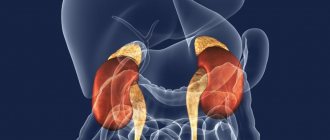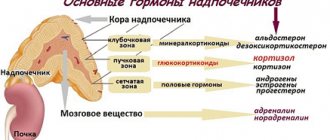Adrenal insufficiency
is one of the most severe polysymptomatic diseases of the endocrine system, which is characterized by a decrease in the production of hormones by the adrenal cortex (glucocorticoids and mineralocorticoids) due to destructive processes in the adrenal glands of various natures.
Otherwise, the pathological process is called hypocortisolism syndrome
,
Addison's disease
.
There are acute and chronic adrenal insufficiency. Chronic adrenal insufficiency, in turn, can be primary, resulting from damage to the adrenal cortex, as well as secondary and tertiary, developing as a result of a pathological process in the pituitary gland or hypothalamus, accompanied by a decrease in the production of adrenocorticotropic hormone.
Classification of chronic adrenal insufficiency
The classification of the disease is based on the etiological factors leading to its development.
1. Primary hypocortisolism
, or
Addison's disease
, can be congenital or acquired. Congenital forms include hypoaldosteronism, adrenoleukodystrophy, Allgrove's syndrome, congenital adrenal hypoplasia and familial isolated glucocorticoid deficiency. Acquired forms of primary hypocortisolism are considered to be autoimmune and infectious adrenalitis, amyloidosis and tumor metastases.
2. Secondary hypocortisolism
associated with damage to the pituitary gland and impaired production of adrenocorticotropic hormone (ACTH). Secondary hypocortisolism can also be congenital (hypopituitarism, isolated deficiency of corticotropic hormone) and acquired, developing as a result of destructive lesions of the pituitary gland (tumors, infections, hemorrhage).
3. Tertiary adrenal insufficiency
, associated with damage to the hypothalamus, is divided into a congenital form, which includes insufficiency of corticoliberin production and multiple hypothalamic insufficiency, and an acquired form, which occurs due to the destruction of hypothalamic tissue.
In addition, there is a type of chronic adrenal insufficiency that arises due to impaired reception of steroid hormones
. This group includes false hypoaldosteronism and iatrogenic adrenal insufficiency caused by taking medications.
Introduction
The term “incidentaloma” of the adrenal gland is a collective term that includes a morphologically diverse group of tumors more than 1 cm in diameter, accidentally detected during a radiological examination [7]. The identified formation may:
- appear to be both hormonally inactive and actively producing various hormones;
- come from different zones of the adrenal gland or have a non-specific organ affiliation;
- be malignant or benign.
The “epidemic” of adrenal incidentalomas is directly related to the widespread use and use of ultrasound, CT, and magnetic resonance imaging (MRI).
Causes and mechanisms of development of chronic adrenal insufficiency
The main cause of primary hypocorticism is considered to be autoimmune damage to the adrenal cortex.
, since it occurs in half of the patients, and can be combined with a number of other autoimmune endocrine pathologies such as diabetes mellitus, hypoparathyroidism, autoimmune thyroiditis, vitiligo, etc., leading to the development of polyendocrine syndrome (autoimmune polyglandular syndrome - simultaneous damage to several endocrine glands with a decrease in their functions).
Another cause of damage to the adrenal cortex is considered infection with tuberculosis.
, and in adults this cause is more common than in children, and the process is usually combined with pulmonary tuberculosis.
In addition, the causes of chronic adrenal insufficiency are metastases to the adrenal glands
of tumors located in other organs,
infectious lesions of the adrenal glands
by viruses, bacteria, fungi,
surgical intervention
or complete removal of the adrenal glands,
hemorrhage
in the adrenal tissue due to the use of anticoagulants.
Secondary and tertiary hypocorticism develop against the background of destructive, traumatic or tumor processes in the pituitary gland and hypothalamus, which result in a violation of corticotropic function (production of ACTH - adrenocorticotropic hormone). Vascular diseases and granulomatous processes in this area, caused by infectious agents, also contribute to the development of chronic adrenal insufficiency.
With primary hypocortisolism, due to a decrease in the production of adrenal hormones - cortisol and aldosterone, water-salt metabolism and other metabolic processes in the body are disrupted. Progressive dehydration, which occurs due to decreased secretion of aldosterone, adversely affects the functioning of the digestive and cardiovascular systems (blood pressure decreases). In addition, cortisol deficiency leads to the development of hypoglycemia, causing muscle weakness, as well as stimulation of the production of adrenocorticotropic and melanocyte-stimulating hormone by the pituitary gland, as a result of which patients develop hyperpigmentation of the skin and mucous membranes. The specific color of the skin of patients explains one of the names of primary hypocortisolism - bronze disease. Insufficient levels of androgens secreted by the adrenal glands lead to delayed growth and puberty.
In secondary chronic renal failure, there is a lack of cortisol, and the secretion of aldosterone remains normal. In this regard, secondary chronic adrenal insufficiency is easier than primary.
DYNAMIC MONITORING
3.1. For low-density hormonally inactive tumors according to primary CT, dynamic observation is not recommended.
3.2. For hormonally inactive tumors, according to the initial examination, monitoring of hormonal activity is not indicated. The exception is new clinical manifestations (the appearance or clinical progression of hypertension, diabetes mellitus, obesity, osteoporosis), about which the patient must be warned.
3.3. If the malignant potential of the tumor is uncertain, tumor size should be monitored after 3–6 months. If the maximum tumor size increases by 5 mm over a short period of observation or the tumor volume increases by 20%, it is necessary to consider surgical treatment.
3.4. In the presence of subclinical hypercortisolism (subclinical Cushing's syndrome (SCS)), annual control of cortisol and monitoring of comorbid conditions (hypertension, diabetes mellitus, obesity, osteoporosis) are indicated.
Signs of chronic adrenal insufficiency
The clinical manifestation of chronic adrenal insufficiency occurs only when most of the glandular tissue of the adrenal glands is destroyed. The main signs of the disease are general weakness and muscle weakness. At the beginning of the pathological process, these signs usually appear only during physiological stress (physical and emotional overload, trauma). Over time, weakness becomes more pronounced towards the end of the day, but after a full night's rest it goes away. As the disease progresses, the feeling of weakness becomes constant and acquires the character of adynamia. From the neuropsychic side, asthenia is observed, accompanied by irritability, lethargy, and decreased libido.
Patients experience weight loss, which is explained by decreased appetite, nausea, vomiting, decreased absorption activity of the intestine, and abnormal bowel movements. A number of patients complain of a constant need for salty foods.
Due to disturbances in the water-salt balance, already in the early stages of the disease one of the main signs of chronic adrenal insufficiency is revealed - a decrease in blood pressure, which can lead to dizziness and fainting.
For primary adrenal insufficiency, a characteristic sign is increased pigmentation of the skin and mucous membranes, which at the beginning of the pathological process is perceived by patients as a long-term preservation of the tan after insolation. The color of the skin can vary from smoky, bronze to very dark, and the color of the mucous membranes can vary from blue-black. At first, areas of the skin that are not protected from the sun (face, neck, hands) and have more pronounced pigmentation normally (armpits, scrotum, nipple areola, perineum) acquire a darker color. Later, pigmentation becomes more widespread and affects areas of the skin in contact with clothing. In patients with autoimmune primary chronic renal failure, small and large non-pigmented light spots of irregular shape can be found against the background of areas with excess pigmentation - vitiligo.
Secondary hypocortisolism is characterized by nonspecific symptoms - general weakness and hypoglycemic attacks, which develop a couple of hours after eating. Hyperpigmentation, disorders of the digestive tract and cardiovascular system are not noted.
Epidemiology
According to summary autopsy statistics, the prevalence of incidentally detected adrenal tumors averages 6% [1, 3]. According to CT data, “random” adrenal formations are detected in approximately 4% of examined patients [2, 12]. Under the age of 30, incidentaloma occurs in approximately 0.2% of those examined, but in the group of patients over 70 years of age, the frequency increases to 7% [13].
Ideas about the frequency of detection of adrenocortical cancer (ACC) in incidentalomas as potentially the most dangerous disease have been revised in connection with the expansion of the clinical research base and the requirements for the nature and design of epidemiological studies. Thus, according to WF Young et al. (2007) [14], the incidence of ACR was estimated at just over 4%. Later, an interclinical analysis [15] of a large number of patients demonstrated the prevalence of ACR among incidentalomas to be no more than 1.9%.
Epidemiological occurrence of various types of tumors when they are accidentally detected (summary literature data)
The diagnostic strategy for incidentaloma of the adrenal gland(s) is determined by two main tasks:
- prove or exclude possible hormonal activity of the tumor;
- determine the malignant potential of the tumor.
Diagnostic criteria for chronic adrenal insufficiency
Since clinical manifestations at the onset of the disease are always vague and nonspecific, when collecting anamnesis, it is important to focus on the time of onset of fatigue, muscle weakness, loss of appetite, weight loss, hyperpigmentation and other signs, as well as the speed of their development and their combination with other signs of adrenal insufficiency.
When examined, patients reveal areas of brown or bronze darkening, especially pronounced in places where clothing rubs, on hems and scars, on the lines of the palms, on the mucous membranes of the oral cavity, in the area of the nipples and external genitalia. In some patients, areas of depigmentation can be detected, which will be evidence of an autoimmune process. Dark freckles are often found on the face of patients.
When measuring the patient's body weight, a decrease is noted. Blood pressure ranges from 90/60 - 100/70 mm Hg. Art., and in patients with concomitant arterial hypertension it is close to normal - 120/80 mm Hg. Art. or moderately increased.
A state of weakness, accompanied by a feeling of hunger and increased sweating, characteristic of hypoglycemia, is observed in patients both on an empty stomach and a couple of hours after eating. In addition, dysfunction of the central nervous system is detected in the form of decreased memory, attention, depression and irritability.
Due to the reduced level of androgens, female patients experience a complete absence or presence of sparse hair in the axillary and pubic areas.
The main diagnostic criterion for chronic adrenal insufficiency is to determine the level of cortisol and aldosterone in the blood. In primary chronic adrenal insufficiency, along with a decrease in the concentration of these hormones, there is also an increase in the level of adrenocorticotropic hormone and renin in the blood plasma.
When performing a blood sugar test, a low level is detected. The concentration of potassium salts in the blood is increased, and the concentration of sodium compounds is decreased.
To make a diagnosis when the clinical picture is blurred, a stimulation test with adrenocorticotropic hormone is used. If, after additional external administration of corticotropin or syncorpin, the level of adrenocorticotropic hormone does not exceed the basal level several times, we can judge that the capabilities of the adrenal cortex have decreased.
The difficulty in making an early diagnosis of chronic adrenal insufficiency arises from the fact that signs of the disease are very often found in other pathologies. Therefore, the disease should be differentiated from neurocirculatory dystonia, which is characterized by general and muscle weakness, but they are leveled out under the influence of psycho-emotional factors, as well as from gastric ulcers, tumor processes, anorexia nervosa, which are characterized by a combination of weight loss with arterial hypotension. In addition to chronic adrenal insufficiency, dark spots on the skin are also observed with pellagra, liver cirrhosis, melanoma, and poisoning with heavy metal salts.
DYNAMIC MONITORING
3.1. For low-density hormonally inactive tumors according to primary CT, dynamic observation is not recommended.
3.2. For hormonally inactive tumors, according to the initial examination, monitoring of hormonal activity is not indicated. The exception is new clinical manifestations (the appearance or clinical progression of hypertension, diabetes mellitus, obesity, osteoporosis), about which the patient must be warned.
3.3. If the malignant potential of the tumor is uncertain, tumor size should be monitored after 3–6 months. If the maximum tumor size increases by 5 mm over a short period of observation or the tumor volume increases by 20%, it is necessary to consider surgical treatment.
3.4. In the presence of SSC, annual control of cortisol and monitoring of comorbid conditions (hypertension, diabetes mellitus, obesity, osteoporosis) are indicated.
Parameters for the follow-up of patients with incidentalomas are the subject of constant debate. In a cross-clinic analysis, TJ Cawood et al. (2009) showed that when a group of 1000 patients was identified according to the criteria of lack of hormonal activity and low malignant potential, not a single case of ACC was missed during 2 years of observation! Monitoring the size of initially low-density small tumors (up to 4 cm) in large samples did not lead to the detection of malignant tumors. Informing the patient about the clinical manifestations of hormonal activity makes it possible to indicate the need for a repeat visit for hormonal examination.
Recommendations for re-examination in borderline clinical situations (with the initial detection of CT density of the native tissue component of about 10–15 HU) vary from 3 to 24 months after the initial detection [2]. In case of suspicious CT data and a small tumor size (up to 3 cm), an initial observation interval of 3 months is considered optimal. According to WF Young Jr. (2007) [14], with sequential observation of patients with various types of adrenal tumors, the growth of cortical adenoma and FCC is 0.5–1.0 cm per year, while ACR is characterized by a rapid growth rate (> 2 cm annually) . It is quite clear that with an uncertain malignant potential at a young age, with large tumors (more than 4 cm), it is possible to make a decision about adrenalectomy without dynamic observation.
Treatment of chronic adrenal insufficiency
The main tasks in developing a treatment regimen for chronic adrenal insufficiency are the earliest and fastest possible elimination of the causative factor that caused damage to the adrenal cortex, as well as replenishment of the deficiency of hormones produced by the adrenal cortex.
After a diagnosis of chronic adrenal insufficiency is made, patients are prescribed replacement therapy with glucocorticoid drugs - hydrocortisone, cortisone acetate, prednisolone. Dexamethasone is not recommended in this case, since it does not replenish mineralocorticoid activity, and contributes to the development of overdose symptoms due to a long period of elimination from the body.
The dosage of the drug is calculated based on the daily secretion of glucocorticoids, and is administered at the rate of two-thirds of the dose in the morning and one-third in the evening. The daily daily dose of hydrocortisone should not exceed 30 mg. Signs of a drug overdose include rapid weight gain, increased blood pressure above normal values, headaches and swelling. If these symptoms develop, the dosage of the drug should be reduced by half.
Fludrocortisone is used to correct mineralocorticoid levels. Take the drug orally once a day on an empty stomach. The dosage of the drug is selected taking into account the severity of the process, the degree of compensation and the general condition of the patient.
Both men and women with chronic adrenal insufficiency are prescribed anabolic steroids. If the patient is exposed to emotional or physical overload, receives injury or surgery, during these periods the dosage of hormones should be increased several times compared to the maintenance level.
All patients with chronic adrenal insufficiency are recommended to eat a diet, the caloric content of which should be a quarter higher than usual for a given age and profession. The diet must be balanced with all the main components, vitamins and microelements. It is advisable to supplement proteins with meat and fish prepared in the form of a variety of dishes. Of the fats, preference is given to butter. Carbohydrates in the diet should be easily digestible, in large quantities, to prevent the development of hypoglycemic conditions. In addition, the diet is enriched with table salt, but foods containing potassium salts - tangerines, apricots, figs, raisins, prunes - are limited. The food of patients should include raw vegetables, fruits and juices.
Treatment of patients with compensated chronic adrenal insufficiency is carried out on an outpatient basis and at home. If stable on hormone replacement therapy, patients should undergo an examination once a year, which includes measurement of weight, pulse, blood pressure, blood electrolytes, fasting blood glucose, and levels of adrenal hormones and adrenocorticotropic hormone. Indications for hospitalization of patients are a state of decompensation, characterized by dehydration, vomiting, and a drop in blood pressure.
With correctly adjusted hormone replacement therapy, the prognosis of the disease is favorable.
Consultations for patients with adrenal diseases are carried out:
| Sleptsov Ilya Valerievich, Endocrinologist surgeon, Doctor of Medical Sciences, Professor of the Department of Surgery with a course in surgical endocrinology, member of the European Association of Endocrine Surgeons | |
| Rebrova Dina Vladimirovna, Endocrinologist, Candidate of Medical Sciences. Assistant at the Department of Endocrinology named after Academician V.G. Baranov, North-Western State Medical University named after I.I. Mechnikov. Member of the European Society of Endocrinologists, International Endocrinological Society, St. Petersburg Association of Endocrinologists. | |
| Fedorov Elisey Alexandrovich, Surgeon-endocrinologist of the highest qualification category, Candidate of Medical Sciences, specialist at the North-West Center for Endocrinology. One of the most experienced surgeons in Russia performing operations on the adrenal glands. The operations are performed using a minimally traumatic retroperitoneoscopic approach through lumbar punctures, without incisions. | |
| Chinchuk Igor Konstantinovich , Endocrinologist surgeon, oncologist, candidate of medical sciences, member of the European Thyroid Association (ETA). Performs endoscopic operations on the adrenal glands. Retroperitoneoscopic approach. More than 350 surgical interventions per year, half of which are endoscopic. |
Consultations are carried out in outpatient branches of the center:
- Petrograd branch
(St. Petersburg, Kronverksky pr., 31, 200 meters from the Gorkovskaya metro station, telephone for appointment, from 7.30 to 20.00, daily);
— Primorsky branch
(St. Petersburg, Savushkina st., 124, building 1, 250 meters to the right from the Begovaya metro station, telephone for appointments from 7.00 to 21.00 on weekdays and from 7.00 to 19.00 on weekends).
For consultation, please bring all available examination results.
ATTENTION PATIENTS!
Currently, the North-Western Endocrinology Center provides free surgical treatment for patients with adrenal tumors
. Treatment is carried out within the framework of the compulsory medical insurance program or the SMP program (specialized medical care).
To obtain free hospitalization for out-of-town patients
you must send copies of documents (passport: page with photo and basic data, page with registration; compulsory health insurance policy, SNILS, results of existing examinations - a detailed list is presented below) to the address
Questions about hospitalization can be asked to the responsible administrator, Valentina Petrovna Kleshnina, by calling +7 900 6291427 (weekdays, from 9 a.m. to 5 p.m.).
Package of necessary examinations
should include the following list (if there are no results from the listed studies, they must be performed in any case):
- CT or MRI of the abdominal cavity, if there is only an ultrasound report, then it is necessary to perform a CT scan of the abdominal cavity without contrast, indicating the native density of the adrenal tumor (if necessary, print this item and show the CT scan to the doctor before the study).
The following laboratory parameters must be determined:
- Aldosterone, renin, potassium in the blood, in case of taking diuretics, they must first be discontinued for three weeks (tests are taken in the morning from 8 to 9 am, sit for 15 minutes before taking the tests), after taking these blood tests, resume taking your previous medications;
- Analysis of 24-hour urine or blood for total metanephrines;
- Performing a test with 1 mg of Dexamethasone (in the evening, at 23:00, take 2 tablets of Dexamethasone, in the morning of the next day - from 8 to 9 in the morning, determining the level of cortisol in the blood), the analysis is taken separately from the others, in the last place.
You must also provide information
about the normal level of blood pressure in the patient (working blood pressure), if the pressure increases, indicate the maximum blood pressure numbers, how long ago the increase has occurred and how often rises in blood pressure occur.
To carry out the above examinations, there is no need to go to the hospital; they can be performed at your place of residence or in the nearest laboratory.
For patients from St. Petersburg
It is advisable to apply for a face-to-face consultation before entering the clinic (make an appointment by phone (812) 565-11-12, Primorsky branch of the center, address: Savushkina St., 124, building 1, make an appointment by phone (812) 498-1030, Petrograd branch of the center, address: Kronverksky pr., 31).
DETERMINING THE MALIGNANT POTENTIAL OF A TUMOR
2.1. To diagnose the malignant potential of a tumor, it is recommended to evaluate quantitative densitometric parameters using three-phase computed tomography (CT):
- density of the tissue component before contrasting (native);
- density in the tissue phase of contrast (arterial and venous phases);
- density in the delayed (10 minutes after contrast administration) contrast phase (washout phase).
2.2. When obtaining high-density CT values in the native phase, contrast delay in the delayed phase, the malignant potential of the tumor should be assessed as high. The exceptions are tumors with a laboratory-confirmed diagnosis of FCC/PG or tumors with a long-term lack of growth dynamics (within 3–5 years). Positron emission tomography (PET) with fluorodeoxyglucose (FDG) labeled with a carbon isotope with a molecular weight of 18 is proposed as the method of choice when metastatic lesions of the adrenal gland are suspected. High metabolic activity (SUV more than 3) is a criterion that allows us to assume with a high degree of probability malignant nature of the tumor.
2.3. A puncture biopsy of an adrenal tumor can be performed if there is a suspicion of metastatic lesions (history of a malignant tumor). In the differential diagnosis of organ-specific adrenal tumors, needle biopsy has no proven advantages and is associated with low sensitivity, specificity and a high likelihood of complications.







